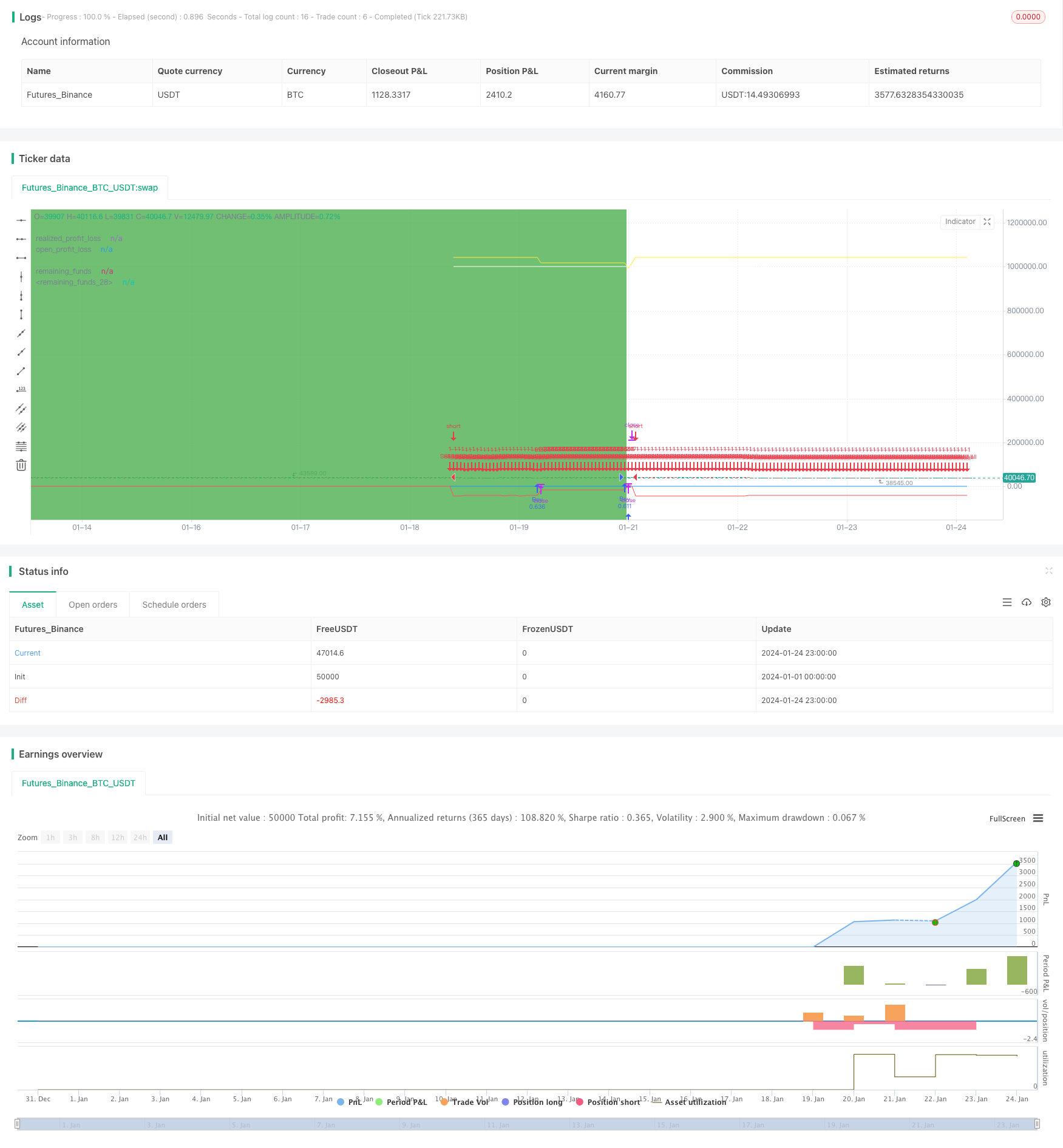
概述
本策略以香港恒生指数ETF(00631L)为投资标的,通过动态调整现金仓位和仓位占比,实时平衡投资组合的收益和风险。策略简单易行,无须判断市场趋势,适合无法频繁查看市场的投资者。
策略原理
初始化投入50%的总资金购买00631L;
监控未实现收益和剩余现金的比例;
当未实现收益超过剩余现金10%时,平掉5%头寸;
当剩余现金超过未实现收益10%时,增买额外5%头寸;
- 动态调整仓位和现金比例,控制投资组合收益和风险。
优势分析
简单容易操作,无须判断市场;
动态调整仓位,有效控制投资风险;
双向跟踪,及时止损止盈;
适合无法频繁check市场的投资者。
风险及对策
- 槓杆ETF波动较大;
采用渐进建仓,分批间隔投入。
- 无法及时止损;
设置止损线,控制最大损失。
- 交易成本较高;
适当放宽平衡幅度,减少调仓。
优化思路
优化仓位和现金比例;
测试不同ETF品种的收益效果;
加入趋势判断指标,提高资金利用效率。
总结
本策略通过构建动态平衡的投资组合,控制投资风险,无须判断市场趋势,操作简单,适合无法频繁check市场的投资者,是一个非常实用的量化投资策略。
策略源码
/*backtest
start: 2024-01-01 00:00:00
end: 2024-01-24 23:59:59
period: 1h
basePeriod: 15m
exchanges: [{"eid":"Futures_Binance","currency":"BTC_USDT"}]
*/
//@version=4
strategy("00631L Trading Simulation", shorttitle="Sim", overlay=true, initial_capital = 1000000)
// 设置本金
capital = 1000000
// 设置购买和出售日期范围
start_date = timestamp(2022, 10, 6)
next_date = timestamp(2022, 10, 7) // 較好的開始日
//start_date = timestamp(2022, 3, 8)
//next_date = timestamp(2022, 3, 9) // 較差的的開始日
sell_date = timestamp(2024, 1, 19)
end_date = timestamp(2024, 1, 21) // 结束日期为2024年01月21日
// 判断是否在交易期间
in_trade_period = time >= start_date and time <= end_date
// 实现的盈亏
realized_profit_loss = strategy.netprofit
plot(realized_profit_loss, title="realized_profit_loss", color=color.blue)
// 未实现的盈亏
open_profit_loss = strategy.position_size * open
plot(open_profit_loss, title="open_profit_loss", color=color.red)
// 剩余资金
remaining_funds = capital + realized_profit_loss - (strategy.position_size * strategy.position_avg_price)
plot(remaining_funds, title="remaining_funds", color=color.yellow)
// 總權益
total_price = remaining_funds + open_profit_loss
plot(total_price, title="remaining_funds", color=color.white)
// 购买逻辑:在交易期间的每个交易日买入 daily_investment 金额的产品
first_buy = time >= start_date and time <= next_date
buy_condition = in_trade_period and dayofmonth != dayofmonth[1]
// 出售邏輯 : 在交易期间的截止日出售所有商品。
sell_all = time >= sell_date
// 在交易期間的第一日買入50%本金
if first_buy
strategy.order("First", strategy.long, qty = capital/2/open)
// 在每个K线的开盘时进行买入
// 加碼邏輯 : 剩余资金 > 未实现的盈亏 * 1.05
add_logic = remaining_funds > open_profit_loss * 1.05
if buy_condition
strategy.order("Buy", strategy.long, when = add_logic, qty = remaining_funds * 0.025 / open)
//
// 減碼邏輯 : 剩余资金 > 未实现的盈亏 * 1.05
sub_logic = open_profit_loss > remaining_funds * 1.05
if buy_condition
strategy.order("Sell", strategy.short, when = sub_logic, qty = open_profit_loss * 0.025/open)
//
strategy.order("Sell_all", strategy.short, when = sell_all, qty = strategy.position_size)
// 绘制交易期间的矩形区域
bgcolor(in_trade_period ? color.green : na, transp=90)